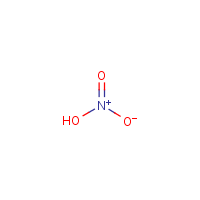Nitric acid
Agent Name
Nitric acid
CAS Number
7697-37-2
Formula
H-N-O3
Major Category
Toxic Gases & Vapors

Synonyms
Acide nitrique [French]; Acido nitrico [Italian]; Acido nitrico [Spanish]; Acidum nitricum; Aqua fortis; Azotic acid; Azotowy kwas [Polish]; Engraver's acid; Hydrogen nitrate; Kyselina dusicne [Czech]; Nital; Nitric acid; Nitrous fumes; Nitryl hydroxide; RFNA; Red fuming nitric acid; Salpetersaeure; Salpetersaure [German]; Salpeterzuuroplossingen [Dutch]; [ChemIDplus] UN2031; UN2032
Category
Acids, Inorganic
Description
Colorless, yellow, or red, fuming liquid with an acrid, suffocating odor. [Note: Often used in an aqueous solution. Fuming nitric acid is concentrated nitric acid that contains dissolved nitrogen dioxide.]; [NIOSH]
Sources/Uses
Used primarily to produce ammonium nitrate fertilizer; also used in metal cleaning, etching, and manufacturing explosives; [ACGIH] Used as a wet etchant in semiconductor manufacturing at a standard concentration of 67%; [CSH, p. 46]
Comments
Liquid causes second or third degree burns after short contact; [CHRIS] Solutions >30% are highly corrosive to skin; Solutions <30% are corrosive; [Quick CPC] Nitrogen dioxide and nitric oxide are usually present as hazards whenever nitric acid is used. Occupational exposure may lead to acute pneumonitis and pulmonary edema. [ACGIH] May cause erosion of teeth enamel; [ICSC]
Biomedical References
Exposure Assessment
Skin Designation (ACGIH)
Insufficient data
TIH
Yes
TLV (ACGIH)
2 ppm
STEL (ACGIH)
4 ppm
PEL (OSHA)
2 ppm
IDLH (NIOSH)
25 ppm
Excerpts from Documentation for IDLHs
Other animal data: Rats receiving a single exposure to 63 mg/m3 nitric acid (24 ppm) exhibited no apparent adverse effects [Diggle and Gage 1954].
Vapor Pressure
63.1 mm Hg
Odor Threshold Low
0.27 ppm
Lethal Concentration
LC50 (rat) = 67 ppm (NO2)/4H
Explanatory Notes
Odor threshold from AIHA; The Guide from the Emergency Response Guidebook is for "nitric acid, fuming." VP from HSDB;
Half Life
No reports found; [TDR, p. 937]
NFPA
will not burn
ERPG-1
1 ppm
ERPG-2
6 ppm
ERPG-3
78 ppm
Adverse Effects
Toxic Pneumonitis
Yes
Dermatotoxin
Skin burns
ACGIH Carcinogen
Not Classifiable
Diseases, Processes, and Activities Linked to This Agent
Diseases
Occupational diseases associated with exposure to this agent:
Processes
Industrial Processes with risk of exposure:
Activities
Activities with risk of exposure: